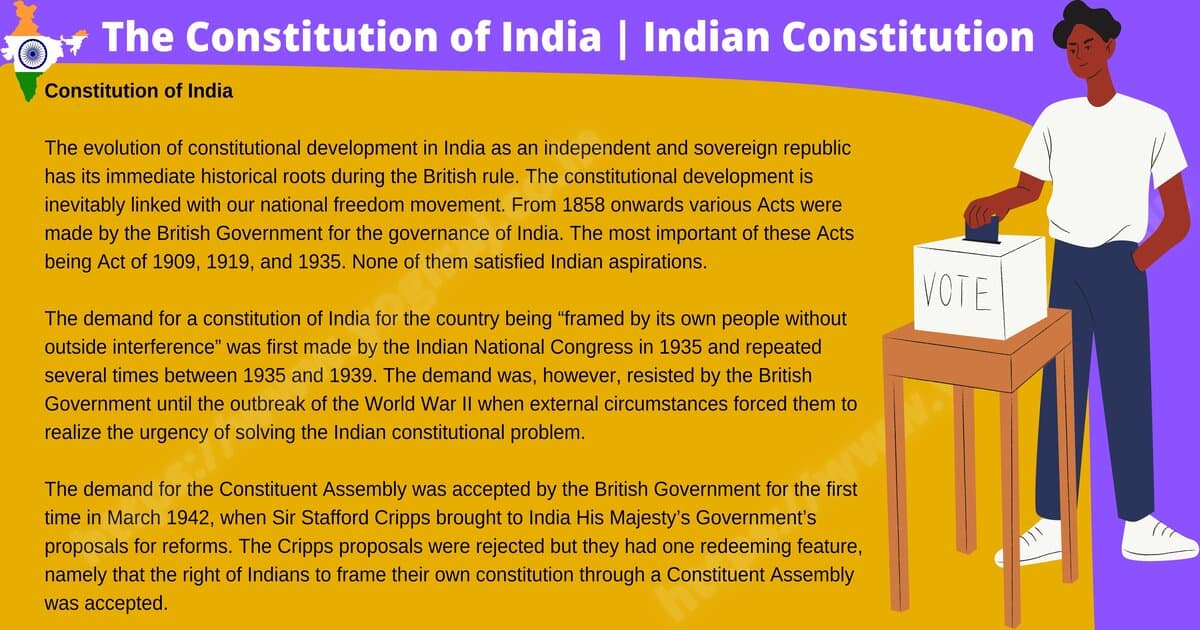The Constitution of India
by Yuvi - January 28, 2021
Constitution of India
The evolution of constitutional development in India as an independent and sovereign republic has its immediate historical roots during the British rule. The constitutional development is inevitably linked with our national freedom movement. From 1858 onwards various Acts were made by the British Government for the governance of India. The most important of these Acts being Act of 1909, 1919, and 1935. None of them satisfied Indian aspirations.
The demand for a constitution of India for the country being “framed by its own people without outside interference” was first made by the Indian National Congress in 1935 and repeated several times between 1935 and 1939. The demand was, however, resisted by the British Government until the outbreak of the World War II when external circumstances forced them to realize the urgency of solving the Indian constitutional problem.
The demand for the Constituent Assembly was accepted by the British Government for the first time in March 1942, when Sir Stafford Cripps brought to India His Majesty’s Government’s proposals for reforms. The Cripps proposals were rejected but they had one redeeming feature, namely that the right of Indians to frame their own constitution through a Constituent Assembly was accepted.
It was under the Cabinet Mission Plan of 1946 that the Constituent Assembly was constituted to frame a Constitution for India. The Constituent Assembly which had been elected for undivided India held its first sitting on 9th December, 1946 and reassembled on 14th August 1947 as the sovereign Constituent Assembly for the Dominion of India.
As a result of the Partition under the Mountbatten Plan of 3 June 1947 a separate Constituent Assembly was set up for Pakistan. The Constituent Assembly of India elected Dr. Rajendra Prasad as its Chairman. On 29 August 1947 the Constituent Assembly appointed a Drafting Committee under the Chairmanship of Dr. Ambedkar.
The Constitution of India was finally adopted on November 26 1949 and came into force on January 26, 1950. The Indian Constitution is the lengthiest and the most comprehensive among all the written constitutions in the world. After about 92 Amendments it now consists of 444 Articles divided into 24 parts and 12 Schedules.
Preamble of Indian constitution
Every Constitution has a philosophy of its own. Our Constitution also has a philosophy which is enshrined in the Preamble to the Constitution. The Preamble serves as an introduction to the Constitution and shows the general purpose for which the Constituent Assembly made the several provisions in the Indian Constitution.
The Preamble indicates that the Indian Constitution derives its power from the people and the source of all authority under the Constitution emanates from the people of India.
Can the Preamble be amended?
For sometime an opinion prevailed that the Preamble to the Constitution was not a part of the Indian Constitution. On this basis it was argued that since it is not a part of the Indian Constitution, the Parliament cannot amend the Preamble by virtue of its amending powers.
However, the Supreme Court in the Kesavananda Bharti case in 1973 overruled its earlier decision and held that the Preamble is a part of the Indian Constitution and is subject to the amending powers of the Parliament as any other provisions of the Constitution, provided the basic structure of the Indian Constitution is not destroyed.
The Indian Constitution (42 Amendment) Act 1976, in fact amended the Preamble and added three new words viz., Socialist, Secular and Integrity, to the Preamble.












